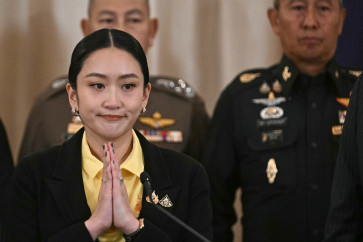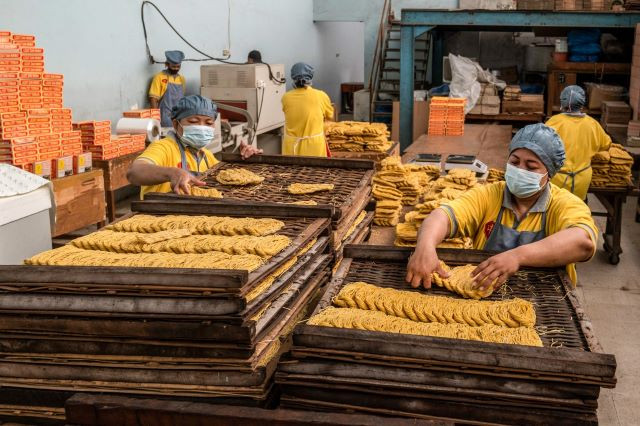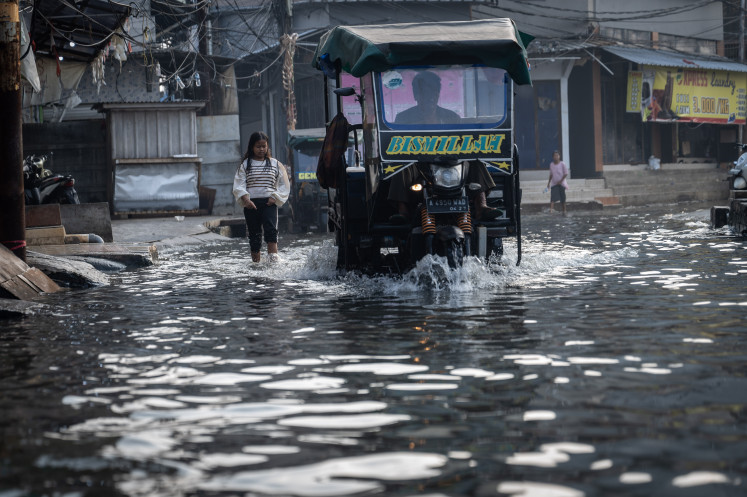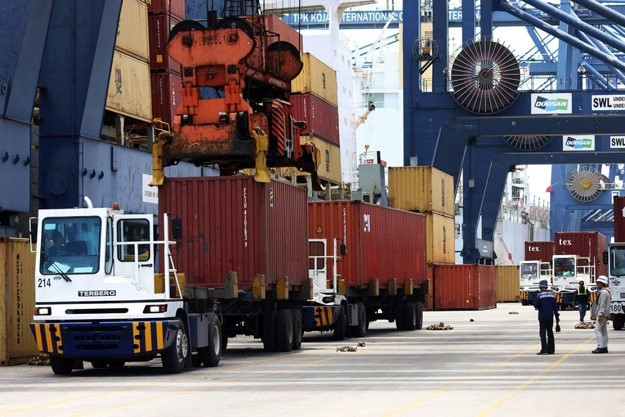Popular Reads
Top Results
Can't find what you're looking for?
View all search resultsPopular Reads
Top Results
Can't find what you're looking for?
View all search resultsWar Revisited
Three Indonesian men stand in a ditch, their backs toward a firing squad
Change text size
Gift Premium Articles
to Anyone

T
hree Indonesian men stand in a ditch, their backs toward a firing squad. While those firing are not in the image, the black and white photo shows a cloud of dust in front of the men: the photo was taken exactly as the bullets went through their bodies and exploded on the soil in front of them. The next photo showed the same ditch filled with corpses, as Dutch soldiers looked on.
These gruesome images appeared in major newspapers on July 10.
“First ever image of executions in the Indies”, read the front page of the Volkskrant daily. Never before had the Dutch public been confronted with visual proof of executions during what is still known in the Netherlands as “police actions”: the fierce clashes on Indonesian soil between the time Sukarno and Hatta proclaimed independence in August 1945, and the official recognition of the Republic of Indonesia in December 1949.
The photos, found in a discarded photo album in a dumpster in the city of Enschede, were published only two weeks after three prominent Dutch institutions headlined national media by calling on the government to conduct a comprehensive research into the 1945-1949 war, and the violence that occurred on both sides.
“Research into the controversial sides of the military actions in Indonesia is necessary,” said the three directors of the Royal Netherlands Institute of Southeast Asian and Caribbean Studies (KITLV), Dutch Institute for Military History (NIMH) and the Institute for War, Holocaust and Genocide Studies (NIOD).
“Not to moralize, but rather to understand what the nature of the violence and the actions were.”
KITLV director Gert Oostindie: “It is important that this study be done, and it is important to do it together with the Indonesian side.”
After World War II ended in August 1945, the Dutch — recently liberated from five years of occupation by Germany — were caught by surprise when their most important colony in the Far East proclaimed its independence. While diplomats from both sides conducted laborious negotiations to resolve their differences, the next four years were marred by bloody clashes.
During that time, the Dutch largely continued to see Indonesia as part of their territory, hence the term “police actions”: sending over some people to restore law and order in troubled regions.
“It’s a ridiculous term,” said Ad van Liempt, whose documentary on the clashes aired this summer. “It wants to give the impression that what happened were just skirmishes.”
Speaking on television show “Nieuwsuur”, Van Liempt said the photos of the execution “are important as they show that this was a ‘real’ war.”
Close to 100,000 Dutch soldiers, out of a population of just under 10 million, were sent off to fight in Indonesia. From those deployed, most of them drafted, some 5,000 died. Death estimates on the Indonesian side — both military and civilians — run to 150,000.
While excesses of that war were discussed sporadically in public, it was only in 1969 that it was thrust into the forefront when Joop Hueting, a veteran who fought under the notorious Capt. Raymond Westerling, told his story on national television. Hueting’s description of harsh punishments, including summary executions, meted out under Westerling’s command in South Sulawesi in late 1946 ignited a wave of public indignation.
The government then ordered historian Cees Fasseur to do an initial study into excesses during the Police Actions. A few months later Fasseur published the results in Excessennota, but hopes that a larger investigation would follow fizzled. After the publication of Excessennota, Labor Party leader Joop den Uyl filed a motion that the government conduct an official investigation into that war.
Parliament struck down the motion, which was “the biggest mistake in this whole affair,” says Van Liempt.
KITLV’s Oostindie explains what the new investigation aims to achieve: “We hope the results would be acceptable for the various groups which have divergent views, and be seen as a frame of reference.”
The renewed call for the research and the publication of the photos have rejuvenated public discussion on the war and sparked a spectrum of reactions.
“This is a chance to rectify the mistake we made in 1969,” said Fasseur in the Volkskrant, referring to the deafening silence following his Excessennota.
Historian Stef Scagliola, who has written a book on the excesses of that war, applauds the initiative and says that “ideally, the study should merge official sources with personal and oral history, both from the Netherlands and Indonesia.”
Not all reactions, however, were positive. In the NRC daily, writer Lizzy van Leeuwen called the initiative “opportunistic” and prompted by the institutions’ “shrinking budgets.” KITLV, NIMH and NIOD are asking for up to ¤3 million for the three-year research.
Another skeptic is Liesbeth Zegveld, the Dutch lawyer who represented the survivors of the 1947 Rawagede massacre in which Dutch soldiers shot dead hundreds of men from the West Javanese village. In a landmark civil suit last year, a court in The Hague granted the survivors financial compensation and apologies for their suffering.
“What sort of research can still be done when most of those directly involved are already deceased? Time has already closed many doors,” Zegveld said in the Volkskrant.
Retired major general Leen Noordzij, chairman of the Former Dutch Indies Veterans Association, says that significant new information could only be obtained if Indonesia opens up its archives. He is skeptical: “Politically, Indonesia has no interest in offering Dutch researchers full access to their archives.”
Noordzij may be more optimistic if he spoke to Indonesian historians like Farabi Fakih, a PhD student at Leiden University: “I think there is a community of Indonesian scholars that are ready to participate in such research in Indonesia.”
Fakih admits, however, that “on a political level, there may be resistance to such a notion, especially amongst the political and popular leadership.”
Fakih, who lectured at Gajah Mada University, points out that “this is an opportunity that could allow for a true reconciliation between both nations by opening up the ugly truths that emanated from both sides.
The problem, Fakih notes, is that most Indonesians view this revolutionary period in their country’s history in black and white.
“There would be great support to uncover Dutch atrocities, but many may seem to be less enthusiastic about uncovering Indonesian ones.”
Scagliola agrees that there are plenty of gray areas: “While Indonesia’s independence movement managed to mobilize international attention, it certainly did not control the whole archipelago. It did not give safety guarantees to minority groups. A lot of people felt threatened, and not just by the Dutch.”
Whether the research would be realized or not, the run up to it has already stirred plenty of — conflicting — emotions.
“It really, really hurts to see those photos,” says Cor de Hoog, a veteran of the war. Speaking on Nieuwsuur, De Hoog explains: “People who have never experienced war would never be able to understand this. You must become tough, because if you don’t you will go mad.”
De Hoog describes corpses of comrades that were found “with throats slit, genitals and ears cut off. Mutilated. It’s too horrible for words.”
Hueting, however, dismisses such comments. He remains as fierce in his criticism on Dutch violence as he did when he appeared on the landmark TV interview in 1969.
“Stories about all those people who had to shoot out of self defense, that’s hogwash. Stories about penises and ears cut off, I’ve never seen any of that. What I have experienced was that Indonesians moved a deceased Dutch soldier under a tree and covered him with palm leaves.”
Fasseur hopes the release of the images would set the ball in motion for the study.
“Many people are made to realize how gruesome war is, and what a gruesome war that was between the Netherlands and Indonesia.”









